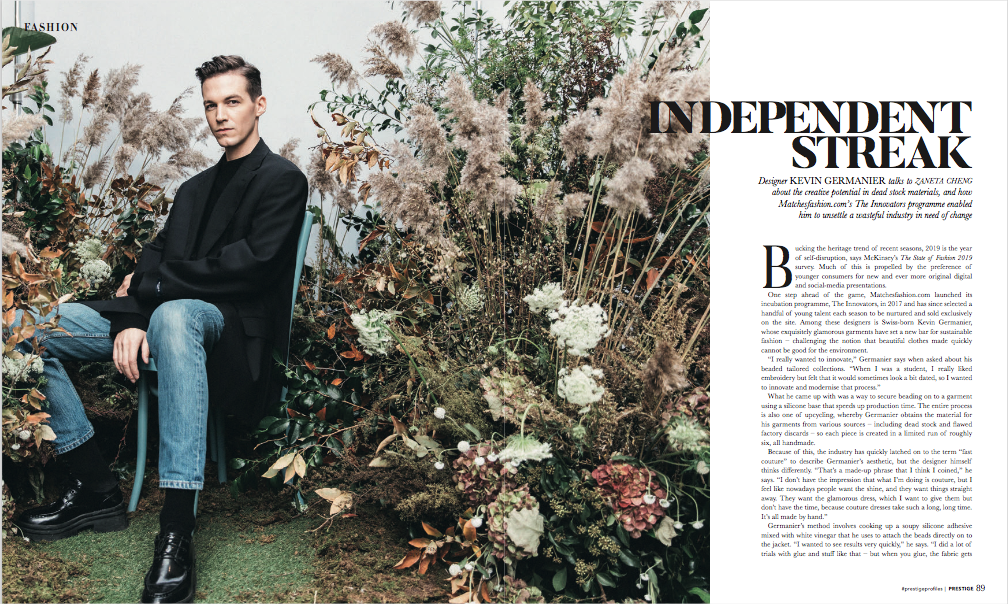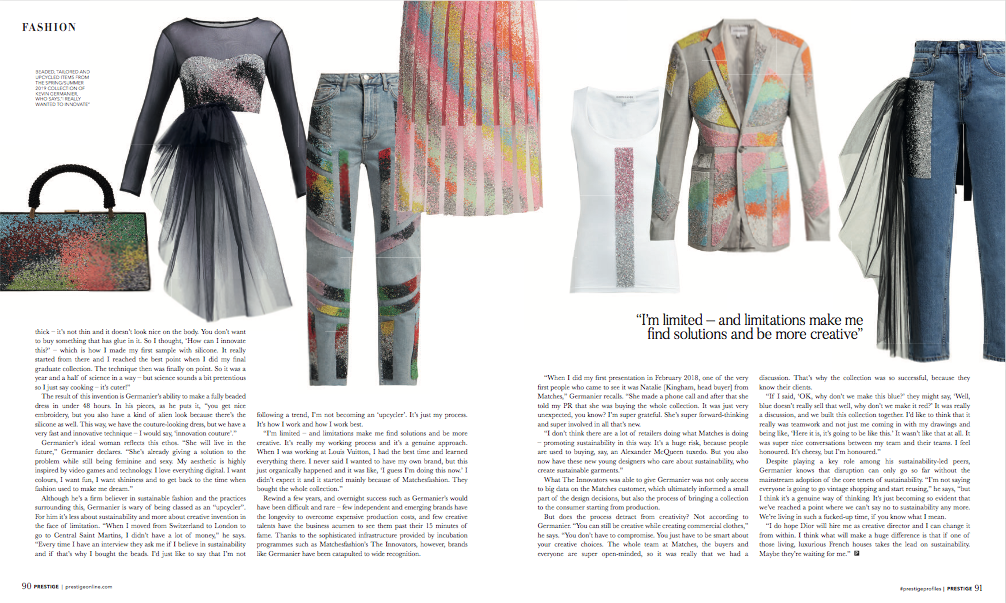Kevin Germanier | Prestige Hong Kong (Mar 19)
Designer KEVIN GERMANIER talks to zaneta cheng about the creative potential in dead stock materials, and how Matchesfashion.com’s The Innovators programme enabled him to unsettle a wasteful industry in need of change
Bucking the heritage trend of recent seasons, 2019 is the year of self-disruption, says McKinsey’s The State of Fashion 2019 survey. Much of this is propelled by the preference of younger consumers for new and ever more original digital and social-media presentations.
One step ahead of the game, Matchesfashion.com launched its incubation programme, The Innovators, in 2017 and has since selected a handful of young talent each season to be nurtured and sold exclusively on the site. Among these designers is Swiss-born Kevin Germanier, whose exquisitely glamorous garments have set a new bar for sustainable fashion – challenging the notion that beautiful clothes made quickly cannot be good for the environment.
“I really wanted to innovate,” Germanier says when asked about his beaded tailored collections. “When I was a student, I really liked embroidery but felt that it would sometimes look a bit dated, so I wanted to innovate and modernise that process.”
What he came up with was a way to secure beading on to a garment using a silicone base that speeds up production time. The entire process is also one of upcycling, whereby Germanier obtains the material for his garments from various sources – including dead stock and flawed factory discards – so each piece is created in a limited run of roughly six, all handmade.
Because of this, the industry has quickly latched on to the term “fast couture” to describe Germanier’s aesthetic, but the designer himself thinks differently. “That’s a made-up phrase that I think I coined,” he says. “I don’t have the impression that what I’m doing is couture, but I feel like nowadays people want the shine, and they want things straight away. They want the glamorous dress, which I want to give them but don’t have the time, because couture dresses take such a long, long time. It’s all made by hand.”
Germanier’s method involves cooking up a soupy silicone adhesive mixed with white vinegar that he uses to attach the beads directly on to the jacket. “I wanted to see results very quickly,” he says. “I did a lot of trials with glue and stuff like that – but when you glue, the fabric gets thick – it’s not thin and it doesn’t look nice on the body. You don’t want to buy something that has glue in it. So I thought, ‘How can I innovate this?’ – which is how I made my first sample with silicone. It really started from there and I reached the best point when I did my final graduate collection. The technique then was finally on point. So it was a year and a half of science in a way – but science sounds a bit pretentious so I just say cooking – it’s cuter!”
The result of this invention is Germanier’s ability to make a fully beaded dress in under 48 hours. In his pieces, as he puts it, “you get nice embroidery, but you also have a kind of alien look because there’s the silicone as well. This way, we have the couture-looking dress, but we have a very fast and innovative technique – I would say, ‘innovation couture’.”
Germanier’s ideal woman reflects this ethos. “She will live in the future,” Germanier declares. “She’s already giving a solution to the problem while still being feminine and sexy. My aesthetic is highly inspired by video games and technology. I love everything digital. I want colours, I want fun, I want shininess and to get back to the time when fashion used to make me dream.”
Although he’s a firm believer in sustainable fashion and the practices surrounding this, Germanier is wary of being classed as an “upcycler”. For him it’s less about sustainability and more about creative invention in the face of limitation. “When I moved from Switzerland to London to go to Central Saint Martins, I didn’t have a lot of money,” he says. “Every time I have an interview they ask me if I believe in sustainability and if that’s why I bought the beads. I’d just like to say that I’m not following a trend, I’m not becoming an ‘upcycler’. It’s just my process. It’s how I work and how I work best.
“I’m limited – and limitations make me find solutions and be more creative. It’s really my working process and it’s a genuine approach. When I was working at Louis Vuitton, I had the best time and learned everything there. I never said I wanted to have my own brand, but this just organically happened and it was like, ‘I guess I’m doing this now.’ I didn’t expect it and it started mainly because of Matchesfashion. They bought the whole collection.”
Rewind a few years, and overnight success such as Germanier’s would have been difficult and rare – few independent and emerging brands have the longevity to overcome expensive production costs, and few creative talents have the business acumen to see them past their 15 minutes of fame. Thanks to the sophisticated infrastructure provided by incubation programmes such as Matchesfashion’s The Innovators, however, brands like Germanier have been catapulted to wide recognition.
“When I did my first presentation in February 2018, one of the very first people who came to see it was Natalie [Kingham, head buyer] from Matches,” Germanier recalls. “She made a phone call and after that she told my PR that she was buying the whole collection. It was just very unexpected, you know? I’m super grateful. She’s super forward-thinking and super involved in all that’s new.
“I don’t think there are a lot of retailers doing what Matches is doing – promoting sustainability in this way. It’s a huge risk, because people are used to buying, say, an Alexander McQueen tuxedo. But you also now have these new young designers who care about sustainability, who create sustainable garments.”
What The Innovators was able to give Germanier was not only access to big data on the Matches customer, which ultimately informed a small part of the design decisions, but also the process of bringing a collection to the consumer starting from production.
But does the process detract from creativity? Not according to Germanier. “You can still be creative while creating commercial clothes,” he says. “You don’t have to compromise. You just have to be smart about your creative choices. The whole team at Matches, the buyers and everyone are super open-minded, so it was really that we had a discussion. That’s why the collection was so successful, because they know their clients.
“If I said, ‘OK, why don’t we make this blue?’ they might say, ‘Well, blue doesn’t really sell that well, why don’t we make it red?’ It was really a discussion, and we built this collection together. I’d like to think that it really was teamwork and not just me coming in with my drawings and being like, ‘Here it is, it’s going to be like this.’ It wasn’t like that at all. It was super nice conversations between my team and their teams. I feel honoured. It’s cheesy, but I’m honoured.”
Despite playing a key role among his sustainability-led peers, Germanier knows that disruption can only go so far without the mainstream adoption of the core tenets of sustainability. “I’m not saying everyone is going to go vintage shopping and start reusing,” he says, “but I think it’s a genuine way of thinking. It’s just becoming so evident that we’ve reached a point where we can’t say no to sustainability any more. We’re living in such a fucked-up time, if you know what I mean.
“I do hope Dior will hire me as creative director and I can change it from within. I think what will make a huge difference is that if one of those living, luxurious French houses takes the lead on sustainability. Maybe they’re waiting for me.”

